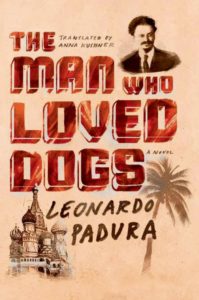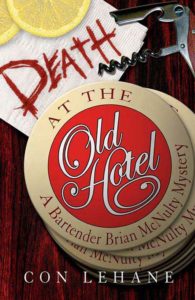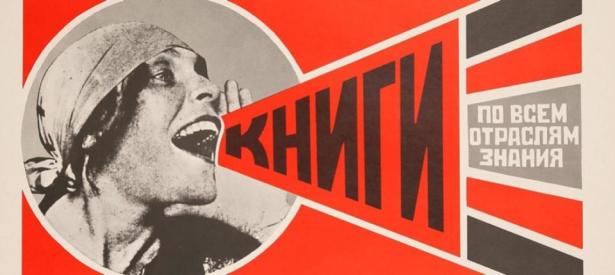Some subject matters and historical settings naturally lend themselves to radical politics. Crime fiction has often had a sympathy and respect for the down-and-out and oppressed. If noir is the moment when obsession and belief turn to action, when inertia is disrupted, then it should be no surprise that the actions of revolutionaries, organizers, and activists drive many a plot. In honor of May Day, we’ve assembled a list of our favorite activist mysteries, organized by kind of activism—from revolutionaries to labor organizers to activists both political and environmental.
From the earliest days of mysteries and thrilling tales, activists have played a role. Not, until more recently, a positive role, but a role nonetheless. In G.K. Chesterton’s The Man Who Was Thursday, a search for anarchists suspected of a bombing drives the plot, and in Joseph Conrad’s The Secret Agent, a political policeman infiltrates a revolutionary cell. The Soviets played well-worn roles throughout Cold War spy fiction, sometimes rendered with nuance, sometimes in extremes, but in general, with complete disregard for any actual political beliefs. At the same time, crime fiction became increasingly sympathetic to the cause of the revolutionary, the activist, the labor organizer, and the environmental campaigner.
This is not a comprehensive list of left-wing mysteries. It is also not a comprehensive list of labor mysteries. (Try Janet Rudolph’s extensive list of crime novels featuring organized labor in honor of Labor Day for a guide.) Noir and crime fiction have always been concerned with telling the tales of the underdog, the downtrodden, the Lumpenproletariat, if you will—and we will, ’cause it’s May Day, gosh darned it. Instead, this is a list of works whose plots are specifically concerned with radical acts.
Readers of the world unite.
REVOLUTIONARIES AND ACTIVISTS
Paco Ignacio Taibo II, Four Hands
Any list of radical detective fiction must start with the greatest radical crime writer of all, Paco Ignacio Taibo II. Many of Taibo’s works feature communists, anarchists, and other radical and revolutionary figures, especially his Mexican Revolution-set works, but since Taibo is also an extremely prolific writer, we’ll only include two of his books on the list, lest we spend the entire post gushing about the radical Renaissance man of our time, and how popular he is on Twitter (1.3 million followers!) Four Hands is a kaleidoscopic tale of intrigue, espionage, politics, and revolution. Two journalists in the 1980s track down info on a plot to slur the Sandinistas and, in the process, go on journey into revolutionary history that alternates between informative and fantastical. Highlights include a subplot wherein Trotsky attempts, and fails, to write a detective novel.
Paco Ignacio Taibo II and Subcommandante Marcos, The Uncomfortable Dead (What’s Missing Is Missing)
Amongst his many forays into radical fiction, Paco Ignacio Taibo II co-wrote a noir novel with Subcommandante Marcos, whose advocacy for the Zapatista Movement easily translates into socially engaged crime fiction. Not to sound too Soviet, but fiction can be used as very effective propaganda, and if you’re looking to scrub your brain free of Ayn Rand forever, The Uncomfortable Dead is a good place to start.

Leonardo Padura, The Man Who Loved Dogs
Cuba’s master of crime fiction is never one to shy away from an epic historical novel. In The Man Who Loved Dogs, he trains his sights on Trotsky’s exile and ultimate murder in Mexico, at the hands of an assassin posing as a Belgian sympathizer, in fact a KGB trained killer doing the bidding of a vengeful Stalin, who wishes to see the old radical titan suffer in the extreme before finally succumbing. Padura also gives us a Cuban perspective (the assassin, Ramón Mercader, spent his final years in Cuba), with a Cuban writer encountering Mercader and subsequently educating himself on the bizarre, spine-chilling horrors of Stalin’s Soviet era. This novel may well be Padura’s crowning achievement: history and crime in all their complex, terrible glory.
Manuel Vázquez Montalbán, Murder in the Central Committee
In Vázquez Montalbán’s 1981 breakthrough novel, former Party member Pepe Carvalho is called from Barcelona to Madrid to investigate a locked-room mystery: the murder of the general secretary of Spain’s Communist Party. As is his habit, Carvalho gets sidetracked by the bounty of wine and food on offer in Madrid, which also afford ample opportunity for tableside philosophizing and remembering his own days as a lefty party man. Murder in the Central Committee holds up as a timeless mystery, but also an investigation of a very particular time and place in Spain’s history, still reeling from the Civil War and the decades of infighting, paranoia, and grudges that followed.
Eva Dolan, This is How it Ends
I know, I keep talking about this book all over the place, but full disclosure: I will never stop talking about this book. Eva Dolan has produced everything I want in a radical crime novel with This Is How It Ends. When two women working together on an anti-gentrification campaign cooperate to cover up a crime, dynamics shift, loyalties are questioned, and intergenerational differences between activists are carefully examined. Of particular note are discussions between characters surrounding the efficacy of direct action and underground activism versus highly visible social media campaigns. All builds to an explosive climax that couldn’t have a more politically satisfying end.
Gary Phillips, The Underbelly
Gary Phillips has worked as a community organizer in LA, and much of his work reflects his commitment to fighting injustice. In The Underbelly, published as part of PM Press’s Outspoken Voices imprint (which also features such radical literary luminaries as Ursula K. Leguin), a Vietnam vet goes looking for a missing buddy previously living on Skid Row, and finds a whole lot of trouble instead (and plenty of occasions to rhapsodize about Californian iniquities). The slimness of the edition belies the effort PM Press has made to contextualize radical narratives, with an interview and other supplementary materials included in the volume.
Boris Akunin, The State Counsellor
Boris Akunin’s Fandorin series, set in the waning days of the Russian Empire, is peppered with revolutionaries, anarchists, and other malcontents chafing under the Tsar, but The State Counsellor has more political characters than any of the others in the series yet translated. After a revolutionary assassin known only as Green commits a brazen act while impersonating Fandorin, the Counsellor must prove his innocence and find the imposter. He teams up with his secret policeman frenemy, the unscrupulous Prince Pozharsky, and as his concerns over methodology increase, he becomes increasingly sympathetic towards the cell of revolutionaries, even as he grows ever-closer to capturing them in brilliant Fandorin fashion. Also, bathhouse intrigue adds a nicely Russian touch.
Massimo Carlotto, The Fugitive
When a student was murdered in Massimo Carlotto’s home in 1976, Carlotto, a member of an activist group, failed to report the crime and, after a complicated and controversial series of trials, fled the country (and has protested his innocence ever since). Imprisoned for a time and eventually pardoned in the early 90s, Carlotto has made several forays into the noir genre, including his autobiographical novel about his time on the run, The Fugitive.
Lewis S. Feuer, The Case of the Revolutionist’s Daughter
Sherlock Holmes gets hired by Frederic Engels to find Marx’s wayward daughter, who may or may not have run away with a member of the (gasp!) Fabian society. The gasp part is because the Fabians, while socialist, had a much milder approach to politics. This book is exceedingly difficult to find, but if you manage to track a copy down, it’s well-worth the effort, with cameos from every major player in late 19th century radical London politics (including George Bernard Shaw).
Kate Raphael, Murder Under the Bridge
A Palestinian policewoman teams up with a lesbian Israeli activist to solve a murder after the Israeli police take little interest in the case. Gay rights advocate and generally rad author Kate Raphael uses the police procedural to examine power dynamics, surveillance, and other aspects of life under occupation. Murder Under the Bridge is grounded in the author’s experience as an activist working in the West Bank.
Jason Overstreet, The Striver’s Row Spy
Overstreet’s crime debut is a perfect surveillance noir, beginging when a recent graduate about to begin his architecture career is instead recruited by the FBI to spy on Marcus Garvey’s Back-to-Africa movement. The architect, not content to support an oppressive state, accepts the position so as to in turn, spy on the FBI and Marcus Garvey for WEB du Bois. A second in the series, Beneath the Darkest Skies, came out earlier this year, and follows the architect and his family to the Soviet Union, where they enjoy the freedoms of black expat life at first, only to quikly have their utopia disproved by Stalin’s bat-sh*t policies.
Walter Mosley, The Red Death
In Mosley’s second work to feature his long-running series character Easy Rawlins, Easy gets in trouble with the IRS and is forced to infiltrate the Los Angeles communist scene and spy on the city’s shrinking radical community in the midst of 1950s red-baiting. The Red Death, along with Jason Overstreet’s The Strivers Row Spy, are stark reminders of the surveillance state and the FBI’s role as politicized police force in African-American history.
Anna Seghers, The Seventh Cross
While most of the works on this list use the police procedural or the murder mystery as the preferred delivery method for radical politics, The Seventh Cross is a politicized example of the “manhunt thriller,” in which a number of prisoners escape a concentration camp in Nazi Germany before the official outbreak of war, and must survive by their wits (and of course, sense of communist brotherhood. The Seventh Cross could be considered part of a larger anti-fascist thriller subgenre popular as a method of using fiction for coalition-building (as in Casablanca), rousing inspiration (as in Anna Segher’s work) or as cathartic fantasy of vengeance (as in Geoffrey Household’s Rogue Male).
Charlie Huston, The Joe Pitt Casebooks
Just cause you’re dead (well, technically, undead) doesn’t mean you have to stop caring about politics. That’s the message of Charlie Huston’s hard-boiled vampire detective series, anyway, where the undead have carved up Manhattan based on political affiliation, and the disputes between anarchist and communist vampires aren’t just background noise—they are integral to the plot.
Kenneth Wishnia, Filomena Buscarsela series
Ken Wishnia’s Filomena Buscarsela series featuring a left-leaning Ecuadorian detective in New York City begins as procedural, but after his protagonist gets kicked off the force for calling out institutional corruption and injustice, this series just keeps getting more and more rad. The Buscarsela series is an extreme example of the disillusioned-police-officer-turned-private-detective-with-socialist-sympathies trope, and owes a debt to Hammett’s Red Harvest and other classic crime novels of conscience, while repurposing the trope for a feminist and international message. The series is rumored to be in development as a TV show, and it would be a pleasure to see Wishnia’s radical heroine kick some ass on-screen.
LABOR ORGANIZERS
Attica Locke, Black Water Rising
Black Water Rising, Attica Locke’s ode to her Civil Rights activist parents, follows Jay Porter, a former Black Power activist turned lawyer, through trials, tribulations, and one epic dockworkers strike, as black longshoreman campaign for equal wages to white dockworkers. Black Water Rising is a fascinating glimpse into Houston in the 1960s, and one of the only works I’ve come across that mentions organized labor in the context of segregation and discrimination in the South. Locke won the 2018 Edgar Award for Best Novel for her most recent release, Bluebird, Bluebird, last Thursday, and we cannot recommend her intricate, epic and socially conscious thrillers enough.
Laura McClure, Organize or Die
In Laura McClure’s Organize or Die!, a washed-up labor organizer is called in to manage negotiations for a union after her more successful colleague is murdered in the midst of a major campaign to organize. McClure’s protagonist must recover her confidence, save the union, and solve a murder. Organize or Die! has been praised both for its entertaining plotline and grasp on the complex process of organizing labor and negotiating for contracts (solving a murder seems downright simple in comparison).
Leye Adenle, Easy Motion Tourist
Leye Adenle’s debut crime novel, Easy Motion Tourist, follows a British reporter and a Nigerian human rights activist who advocates for sex workers, as they work together to find out who’s murdering Lagos’ most vulnerable population. Are these ritual murders? Or are the evidence of a sinister conspiracy? Easy Motion Tourist made it on the list because this book treats sex workers as workers, entitled to respect, advocacy, and organized action, which is why we have it under the labor activism category.

Con Lehane, Death at the Old Hotel
Lehane’s bartender protagonist, Brian McNulty, gets involved in the trials and tribulations of hotel union workers after a fight on the picket line and a murder complicate an already-complex labor negotiation. Lehane has worked as a bartender, teacher, and organizer, and he renders labor struggles with nuance and context.
Dennis Lehane, The Given Day
Lehane’s epic 2008 novel follows the early days of the unionization of the Boston police force, leading up to the Strike in 1919, and the formation of the NAACP. Yes, the former may not sound too radical now (police unions not exactly known for their activism), but in the moment, labor forces were swelling around the country, and there was concern that the police unions would even join in a May Day revolt, giving federal authorities enough pause to work to infiltrate the burgeoning union movement, just like they’d ultimately move to work against the NAACP.
Gordon DeMarco, October Heat
Gordon DeMarco worked as a publisher and an author of radically-oriented crime fiction, and a reviewer on GoodReads called his PI, Riley Kovachs, “Mike Hammer with a socialist bent.” October Heat takes place during the 1934 West Coast waterfront strike, and uses the murder mystery form to examine complex dynamics between labor organizations while retaining a healthy sense of humor about the genre, with characters named things like “Helvetica Bold.”
Dashiell Hammett, Red Harvest
Inspired by the copper miners’ strike in Butte Montana and the subsequent Butte’s Anaconda Road Massacre in 1920, Hammett’s classic sends the Continental Op to “Personville” (aka Poisonville) to take on the local gangs running roughshod over the town, gangs who were themselves called in as strikebreakers and radical thumpers. Although Hammett’s own time as a PI pitted him against the unions more often than not, he spent much of his later career as a labor stalwart, serving as president of the Civil Rights Congress, overseeing its bail fund for political prisoners, and ultimately refusing to testify in front of HUAC, a stand that would earn him a stint in federal prison in West Virginia.
ENVIRONMENTAL ACTIVISTS AND NGO WORKERS
John le Carré, The Constant Gardener
In le Carré’s 2001 novel, Tessa, the aid worker and activist, meets an untimely end after collecting damning evidence against the big pharmaceutical companies running crooked drug tests in East Africa. Her murder sets her new husband, a High Commission diplomat, into a murky, dangerous world of exploitation, official corruption, and (this is a le Carré novel after all) personal disillusionment.
Kwei Quartey, Murder at Cape Three Points
On the Ghana coast, in an oil-rich area, a prominent local couple is murdered and set adrift in a canoe. Detective Inspector Darko Dawson is called in on the case and delves into a world of corporate excess and greed, pitted against the local fishermen whose industry has been ravaged by the oil sector, as well as the activists and NGO workers allied against the region’s shadowy financial interests.
Send My Love and a Molotov Cocktail! Edited by Gary Phillips and Andrea Gibbons
This may be the strangest item on this list, given this short story collection’s…variable…subject matter. Part of PM Press’ hard-boiled and socially engaged Switchblade imprint, Send My Love and a Molotov Cocktail! (SMLAAMC!) contains a number of activist-oriented tales, including “Orange Alert,” by Summer Brenner, in which an act of civil disobedience is planned by a group of radical retirees, and “Murder…Then and Now,” by Penny Mickelbury, a tale of revenge against an FBI informant decades after a black revolutionary organization is torn apart by the spy in their midst. And then, there’s the wacky novella “Gold Diggers of 1977” by Michael Moorcock, wherein his staple character Cornelius and co. somehow come into conflict with the Sex Pistols’ manager, all set to a raging punk soundtrack.
Edward Abbey, The Monkey Wrench Gang
I volunteered at an anarchist bookstore in Austin called Monkeywrench Books for years, and so Abbey’s classic of environmental activism will always have a special resonance. A group of environmental activists engage in industrial sabotage in what would become a cult classic and a rallying cry for the environmentalist movement.
Honorable mention: Piekke Biermann, German sex worker, activist, and crime writer, who authored numerous “frauenkrimi” during the 1980s that have yet to be translated into English, despite making their way into German college courses as required reading.


Spread the word